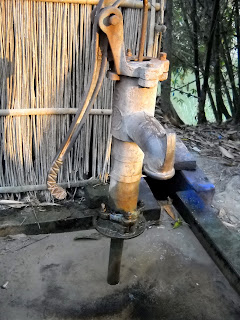What does one drink in Bangladesh? Keeping hydrated in a tropical country is crucial. Part of the wealth of Bangladesh is its accessibility to clean drinking water from ‘tube wells’ which can be sunk 30 – 60 feet anywhere in the country and which provide relatively safe drinking water.
 Bangladesh’s natural version of bottled water is dab -green coconut water. Train station platforms often have a dabwaller who will cut open a fresh green coconut with an opening for drinking. It is healthy and tasty.
Bangladesh’s natural version of bottled water is dab -green coconut water. Train station platforms often have a dabwaller who will cut open a fresh green coconut with an opening for drinking. It is healthy and tasty.
 Now tea- this is a Bengali drink. A cup of chai (small and strong with milk and sugar) is more than a cup of tea. You open friendships, seal agreements, entertain any guest, and mark the end of a visit with a cup of chai. A product of the country’s northeast districts which are swathed in tea gardens, the leaves make their way to every nook and cranny of Bangladesh where local vendors fix you a cup in minutes for 8 cents. On trains they charge the outrageous price of 10 cents.
Now tea- this is a Bengali drink. A cup of chai (small and strong with milk and sugar) is more than a cup of tea. You open friendships, seal agreements, entertain any guest, and mark the end of a visit with a cup of chai. A product of the country’s northeast districts which are swathed in tea gardens, the leaves make their way to every nook and cranny of Bangladesh where local vendors fix you a cup in minutes for 8 cents. On trains they charge the outrageous price of 10 cents.
 Bangladesh’s natural version of bottled water is dab -green coconut water. Train station platforms often have a dabwaller who will cut open a fresh green coconut with an opening for drinking. It is healthy and tasty.
Bangladesh’s natural version of bottled water is dab -green coconut water. Train station platforms often have a dabwaller who will cut open a fresh green coconut with an opening for drinking. It is healthy and tasty. If you prefer to go for modern ‘bottled water’ and want to pay the exorbitant price of 15 taka (25 cents) per litre, you can buy a bottle of “Fresh” (brand name) drinking water. A description of the purification process is included on the bottle:
Superfresh drinking water is treated by reverse osmosis, ultrviolated and ozonated.
We may wonder about the moral ramifications of drinking violated water but have given in and often bought it for trips.
 Now tea- this is a Bengali drink. A cup of chai (small and strong with milk and sugar) is more than a cup of tea. You open friendships, seal agreements, entertain any guest, and mark the end of a visit with a cup of chai. A product of the country’s northeast districts which are swathed in tea gardens, the leaves make their way to every nook and cranny of Bangladesh where local vendors fix you a cup in minutes for 8 cents. On trains they charge the outrageous price of 10 cents.
Now tea- this is a Bengali drink. A cup of chai (small and strong with milk and sugar) is more than a cup of tea. You open friendships, seal agreements, entertain any guest, and mark the end of a visit with a cup of chai. A product of the country’s northeast districts which are swathed in tea gardens, the leaves make their way to every nook and cranny of Bangladesh where local vendors fix you a cup in minutes for 8 cents. On trains they charge the outrageous price of 10 cents.
We were really outrageous and payed a dollar per cup (70 taka) for ‘7 layer tea’ -a concoction of seven layers of variously flavored tea all served in the same glass. We drank this during our tour of the Sri Mongol tea estates. The novelty of being able to experience this carefully guarded secret process was worth the outrageous price.

No comments:
Post a Comment